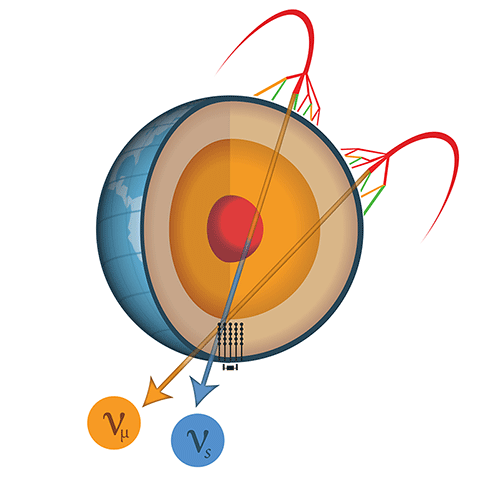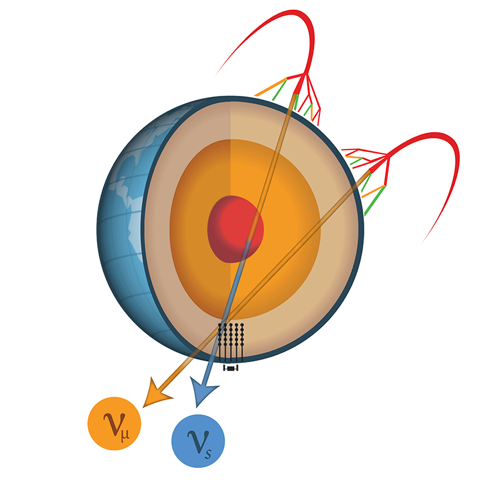Hunting the Sterile Neutrino
Neutrinos only interact with matter through the feeblest of forces, the weak nuclear force and gravity, yet they play critical roles in an incredible range of phenomena. They influenced the formation of the early Universe and may be the reason why matter came to dominate over antimatter shortly after the big bang. They are also integral to the inner workings of stars, including during their explosive demise as a supernova. Moreover, neutrinos are practically everywhere: even a single banana emits a million neutrinos a day from the unstable potassium isotopes it contains.
Although only three types of neutrino are known to exist, hints of a new kind of neutrino that solely interacts with matter through gravity have appeared in several experiments. If such a “sterile” neutrino does indeed exist, it might also play an important role in the evolution of the Universe. The hunt for sterile neutrinos has gone on for decades and has been full of twists and turns, with tantalizing positive signals that were later found to be in tension with null results in follow-up experiments. Now the world’s largest neutrino detector, the IceCube experiment at the South Pole, has released an analysis that eliminates a large portion of the parameter space in which sterile neutrinos could exist [1].
Standard neutrinos come in three flavors, each of which is associated with a charged partner: the electron, muon, or tau particle. The discovery that neutrinos oscillate, meaning one type of neutrino can transform into another, led to the realization that each flavor state is a linear superposition of three mass states with masses , , and —a beautiful example of basic quantum mechanics at work (see 7 October 2015 Focus story.) Based on precision oscillation measurements, we know that the mixing between neutrinos is quite large compared to similar effects among the quarks. Also, the distance needed for one neutrino type to turn into another, the neutrino oscillation wavelength, is determined by the difference between the squared masses of the participating mass states. These differences, and , are known with good precision for the standard neutrinos.
However, experiments have found possible evidence for neutrinos oscillating with a wavelength that doesn’t match any combination of the known neutrino masses. The most significant results are from the Liquid Scintillator Neutrino Detector (LSND) experiment at Los Alamos National Lab, which observed electron antineutrinos appearing in a beam of muon antineutrinos [2], and from the Mini Booster Neutrino Experiment (MiniBooNE) at Fermilab, which found excesses of both electron neutrinos and antineutrinos [3]. Other hints come from the anomalous disappearance of electron neutrinos and antineutrinos produced in nuclear power reactors [4] or by powerful radioactive sources [5, 6].
Neutrino oscillations involving sterile neutrinos can be understood if there is a fourth mass state with mass . This fourth state must be mostly sterile, containing only a small mixture of the standard neutrino flavors. If it exists, then it should be possible to observe small-amplitude neutrino oscillations with a wavelength set by the difference between and the square of the mass of one of the standard neutrino mass states. (Limits on the neutrino masses from cosmological measurements suggest that the hypothetical fourth mass state would have to be heavier than the standard neutrino mass states.) So far, the positive experimental hints for sterile neutrinos point to a squared-mass difference somewhere in the range 0.1–10 .
Unlike the “traditional” particle physics experiments that have undertaken searches for sterile neutrinos, IceCube is primarily designed to detect high-energy neutrinos from some of the most powerful astrophysical events in the Universe. The detector is spread over a cubic kilometer and consists of thousands of optical sensors buried in the Antarctic ice. When a high-energy neutrino interacts with the ice, it creates charged particles. These in turn produce large amounts of light. From the amplitude and timing of these light signals, the IceCube researchers can reconstruct the properties of the parent neutrino that induced the interaction.
The key to IceCube’s sensitivity to sterile neutrinos is its ability to determine, with high accuracy, the energy and arrival direction of muon neutrinos and antineutrinos that are produced in Earth’s atmosphere with energies around 1 TeV. Normally, the oscillation of muon neutrinos caused by an additional neutrino mass state should be small. But if this oscillation occurs as the neutrinos pass through dense matter, it may be greatly enhanced by a so-called matter-induced resonance effect [7], creating a sizable disappearance of the muon neutrinos at certain energies. (The precise energy depends on the mass of the hypothetical fourth mass state.) In a unique experiment, the IceCube researchers have tapped into this matter effect by looking for the disappearance of atmospheric muon neutrinos and antineutrinos that have arrived from the North Pole and have therefore passed through Earth’s dense core (see Fig. 1). They looked for this disappearance for neutrinos and antineutrinos with energies between 320 GeV and 20 TeV, a range in which the matter effect has not been explored before. Assuming the additional neutrino mass state is heavier than the known neutrinos, a nearly 100% disappearance of muon antineutrinos is expected at the resonant energy. However, no such disappearance is observed in the energy range explored by IceCube.
IceCube’s finding places strong limits on the possible existence of a sterile neutrino. In fact, a new analysis incorporating IceCube’s result with data from other experiments indicates that the value of the possible sterile-neutrino mass splitting is now limited to a small region around 1 to 2 [8]. Several new experiments are being constructed to explore exactly this region. Researchers are, for example, planning next-generation experiments to search for the disappearance of electron antineutrinos from nuclear reactors and radioactive sources. At Fermilab, we are building the Short-Baseline Neutrino (SBN) program using an accelerator neutrino beam and three precision detectors [9]. SBN will investigate both muon-neutrino disappearance and electron-neutrino appearance with maximum sensitivity in exactly the 1–2 region. With the first SBN detector already running and the remaining two scheduled to begin operation in 2018, we are poised to settle the question of the sterile neutrino’s existence in the coming years. Whether we will soon rule out the possibility of sterile neutrinos in this region or are narrowing in on a thrilling discovery is still to be determined. But thanks to IceCube’s new result, we have a much better idea of where to look.
This research is published in Physical Review Letters.
References
- M. G. Aartsen et al. (IceCube Collaboration), “Searches for Sterile Neutrinos with the IceCube Detector,” Phys. Rev. Lett. 117, 071801 (2016).
- A. Aguilar et al. (LSND Collaboration), “Evidence for Neutrino Oscillations from the Observation of Appearance in a Beam,” Phys. Rev. D 64, 112007 (2001).
- A. A. Aguilar-Arevalo et al. (MiniBooNE Collaboration), “Improved Search for Oscillations in the MiniBooNE Experiment,” Phys. Rev. Lett. 110, 161801 (2013).
- G. Mention, M. Fechner, Th. Lasserre, Th. A. Mueller, D. Lhuillier, M. Cribier, and A. Letourneau, “Reactor Antineutrino Anomaly,” Phys. Rev. D 83, 073006 (2011).
- W Hampel et al. (GALLEX Collaboration), “Final Results of the Neutrino Source Experiments in GALLEX,” Phys. Rev. B 420, 114 (1998).
- J. N. Abdurashitov et al. (SAGE Collaboration), “Measurement of the Response of a Gallium Metal Solar Neutrino Experiment to Neutrinos from a Source,” Phys. Rev. C 59, 2246 (1999).
- H. Nunokawa, O. L. G. Peres, and R. Zukanovich Funchal, “Probing the LSND Mass Scale and Four Neutrino Scenarios with a Neutrino Telescope,” Phys. Lett. B 562, 279 (2003).
- G. H. Collin, C. A. Arguelles, J. M. Conrad, and M. H. Shaevitz, “First Constraints on the Complete Neutrino Mixing Matrix with a Sterile Neutrino,” arXiv:1607.00011.
- R. Acciarri et al. (ICARUS-WA104, LAr1-ND, MicroBooNE Collaborations), “A Proposal for a Three Detector Short-Baseline Neutrino Oscillation Program in the Fermilab Booster Neutrino Beam,” arXiv:1503.01520.





